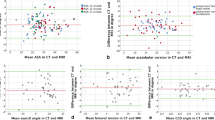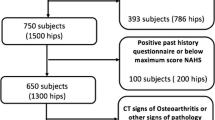Abstract
Purpose
Characterizing aspheric deformities of the femoral head–neck junction in cam-type femoroacetabular impingement (FAI) requires representing the location, size, or extent of the bony lesion. The objectives of this work are to (1) assess the feasibility of creating 3D models of cam deformities from MRI sets, (2) present a standardized 2D visualization of the lesion, and (3) present and evaluate the potential utility of summary metrics in distinguishing between FAI patients and control subjects.
Methods
Using MRIs from five subjects with diagnosed cam-type FAI and four healthy subjects, we developed a technique based on subtracting an estimated normal surface from each subject’s actual bone surface in order to generate a subject-specific 2D “diagnosis graph” that characterized the femoral deformity. The models from three control subjects were combined to create the baseline model.
Results
The RMS fitting error between the surface models of individual control subjects and their corresponding baseline models was 1.05 mm across the head and the head-to-neck transition region. In the anterosuperior region of the 2D diagnosis graphs, the mean height of the detected cam deformities relative to the estimated baseline normal shape was 17.9 % of the head radius for the five FAI subjects (95 % CI 8.5–27.3 %) and 7.0 % (95 % CI 2.9–11.1 %) for the four control subjects. A binary logistic regression analysis indicated that an h/r ratio larger than a threshold of \(\varepsilon \) = 10.7 % (equivalent to approximately 2.3 mm in height) yielded the best discrimination between cam-type FAI subjects and normal subjects.
Conclusions
Our 2D diagnosis graph qualitatively enabled the cam-type lesions in four of our five diagnosed patients to be clearly visualized on MRI-derived models. We believe this visualization tool may be helpful in better characterizing cam-type lesions for diagnosis and for developing more precise plans for surgical treatment.






Similar content being viewed by others
References
Beall DP, Sweet CF, Martin HD, Lastine CL, Grayson DE, Ly JQ et al (2005) Imaging findings of femoroacetabular impingement syndrome. Skel Radiol 34(11):691–701
Groh MM, Herrera J (2009) A comprehensive review of hip labral tears. Curr Rev Musculoskelet Med 2(2):105–117
Keogh MJ, Batt ME (2008) A review of femoroacetabular impingement in athletes. Sports Med 38(10):863–878
Reichenbach S, Leunig M, Werlen S, Nüesch E, Pfirrmann CW, Bonel H et al (2011) Association between cam-type deformities and magnetic resonance imaging-detected structural hip damage: a cross-sectional study in young men. Arthr Rheum 63(12):4023–4030
Leunig M, Jüni P, Werlen S, Limacher A, Nüesch E, Pfirrmann CW et al (2013) Prevalence of cam and pincer-type deformities on hip MRI in an asymptomatic young Swiss female population: a cross-sectional study. Osteoarthr Cartil 21(4):544–550
Reid GD, Reid CG, Widmer N, Munk PL (2010) Femoroacetabular impingement syndrome: an underrecognized cause of hip pain and premature osteoarthritis? J Rheumatol 37(7):1395–1404
Audenaert EA, Baelde N, Huysse W, Vigneron L, Pattyn C (2011) Development of a three-dimensional detection method of cam deformities in femoroacetabular impingement. Skelet Radiol 40(7):921–927
Nötzli HP, Wyss TF, Stoecklin CH, Schmid MR, Treiber K, Hodler J (2002) The contour of the femoral head-neck junction as a predictor for the risk of anterior impingement. J Bone Jt Surg Br 84(4):556–560
Johnston TL, Schenker ML, Briggs KK, Philippon MJ (2008) Relationship between offset angle alpha and hip chondral injury in femoroacetabular impingement. Arthroscopy 24(6):669–675
Kaplan KM, Shah MR, Youm T (2010) Femoroacetabular impingement-diagnosis and treatment. Bull NYU Hosp Jt Dis 68(2):70–75
Brunner A, Horisberger M, Herzog RF (2009) Evaluation of a computed tomography-based navigation system prototype for hip arthroscopy in the treatment of femoroacetabular cam impingement. Arthroscopy 25(4):382–391
Gu D-Y, Dai K-R, Hu F, Chen Y-Z (2010) The shape of the acetabular cartilage surface and its role in hip joint contact stress. In: Proceedings of the conference of IEEE Engineering in Medicine and Biology Society, pp 3934-3937
Lohan DG, Seeger LL, Motamedi K, Hame S, Sayre J (2009) Cam-type femoral-acetabular impingement: is the alpha angle the best MR arthrography has to offer? Skelet Radiol 38(9):855–862
Li W, Abram F, Beaudoin G, Berthiaume M-J, Pelletier J-P, Martel-Pelletier J (2008) Human hip joint cartilage: MRI quantitative thickness and volume measurements discriminating acetabulum and femoral head. IEEE Trans Biomed Eng 55(12):2731–2740
Guillard G, Magnenat-Thalmann N (2007) Ball-and-socket joint motion description using spherical medial representation. In: Proceedings of the conference of IEEE Engineering in Medicine and Biology Society, pp 4293–4296
Korein JU (1985) Geometric investigation of reach. 20 June 1985. Available from: http://mitpress.mit.edu/catalog/item/default.asp?ttype=2&tid=6321
Kitware, National Library of Medicine Insight Segmentation and Registration Toolkit (ITK). http://www.itk.org/
Spitz SN, Spyridi AJ, Requicha AG (1999) Accessibility analysis for planning of dimensional inspection with coordinate measuring machines. IEEE Trans Robot Autom 15(4):714–727
Kang XM (2010) Dynamic fixture planning in virtual environments. Dissertation, University of Manitoba
Reinbacher C (2009) Semi automatic segmentation of articular cartilage using variational methods [Internet]. Graz University of Technology, Graz, Austria (cited 30 January 2013). Available from: http://www.icg.tugraz.at/Members/reinbacher/mastersthesis.2010-02-27.8699452951
Audenaert E, Vigneron L, Pattyn C (2011) A method for three-dimensional evaluation and computer aided treatment of femoroacetabular impingement. Comput Aided Surg 16(3):143–148. doi:10.3109/10929088.2011.557856
Acknowledgments
Dr. Kang was supported by the Natural Sciences and Engineering Research Council of Canada (NSERC) through a Postdoctoral Fellowship and conducted her research at the Center for Hip Health and Mobility at Vancouver General Hospital, Canada.
Conflict of Interest
The authors declare that they have no conflict of interest.
Author information
Authors and Affiliations
Corresponding author
Rights and permissions
About this article
Cite this article
Kang, X., Zhang, H., Garbuz, D. et al. Preliminary evaluation of an MRI-based technique for displaying and quantifying bony deformities in cam-type femoroacetabular impingement. Int J CARS 8, 967–975 (2013). https://doi.org/10.1007/s11548-013-0837-3
Received:
Accepted:
Published:
Issue Date:
DOI: https://doi.org/10.1007/s11548-013-0837-3




